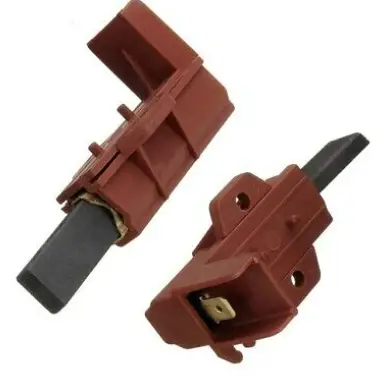Washing machines have become an essential part of our daily lives, making laundry chores much more convenient.
However, like any mechanical device, they can experience issues over time.
One common component that plays a crucial role in a washing machine’s operation is the motor brushes.
In this article, we’ll delve into what washing machine motor brushes are, why they fail, whether they can be fixed, or replaced, and the associated costs.
What Are Washing Machine Motor Brushes?
Washing machine motor brushes are small, typically rectangular-shaped components made of carbon or graphite that make contact with the armature of the washing machine’s electric motor.
These brushes play a vital role in transferring electrical current to the motor’s armature, creating the rotational motion needed for the drum to agitate and spin during a wash cycle.
Why Do Washing Machine Motor Brushes Fail?
Over time, washing machine motor brushes can wear out and fail due to several factors:
Normal Wear and Tear: The continuous friction between the brushes and the armature causes gradual wear, eventually leading to brush replacement.
Overuse: Frequent and heavy use of the washing machine can accelerate the wear and tear of motor brushes.
Poor Maintenance: Lack of regular maintenance can contribute to the brushes deteriorating prematurely.
Age: Older washing machines are more likely to experience motor brush failure.
Washing Machine Motor Brushes Be Fixed?
In some cases, washing machine motor brushes can be temporarily restored by cleaning and reseating them properly.
This solution may work if the brushes are just worn down but not damaged. However, it’s a short-term fix, and the brushes will likely need replacement eventually.
Can You Replace Washing Machine Motor Brushes?
Yes, washing machine motor brushes can be replaced. Here’s how to do it:
1. Safety First: Always unplug the washing machine from the power source and ensure it’s not connected to any electrical supply before attempting any repairs.
2. Access the Motor: Depending on your washing machine’s design, you may need to remove the back or top panel to access the motor.
3. Locate the Brushes: Once you’ve accessed the motor, you’ll find the brushes connected to it. They are typically held in place with screws or clips.
4. Remove Old Brushes: Carefully disconnect the wires attached to the brushes, and then remove the brushes from their holders.
5. Install New Brushes: Insert the new brushes into the holders and reattach the wires as they were on the old brushes.
6. Reassemble and Test: Put the washing machine back together, plug it in, and run a test cycle to ensure the new brushes are working correctly.
Washing Machine Motor Brushes Expensive to Replace?
The cost of replacing washing machine motor brushes can vary depending on factors like the brand and model of your appliance, the availability of replacement parts, and whether you hire a technician or do it yourself.
On average, the cost of a set of motor brushes can range from $10 to $30. If you hire a professional technician, labor costs may also apply.
Can You Replace Washing Machine Motor Brushes Yourself?
Replacing washing machine motor brushes is a DIY-friendly task if you’re comfortable with basic tools and have some technical knowledge.
However, if you’re unsure about your abilities or if your machine is under warranty, it’s advisable to consult a qualified technician or contact the manufacturer for assistance.
Final Thoughts
In conclusion, washing machine motor brushes are essential components that can wear out over time due to normal use and other factors.
While they can be replaced, it’s important to prioritize safety and, if needed, seek professional help to ensure your washing machine operates efficiently and safely.
Replacing motor brushes is a cost-effective way to extend the life of your washing machine and keep your laundry routine running smoothly.
Related Articles
- Washing Machine Inverter? For Beginners (Simple Answers)
- Washing Machine Control Board 101: For Beginners
- Washing Machine Motor 101: Beginners Guide
References
- Image by wayhomestudio on Freepik


